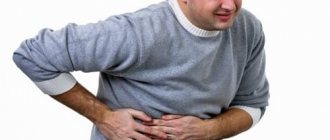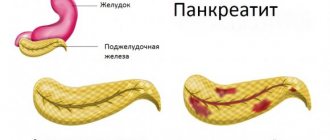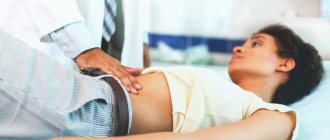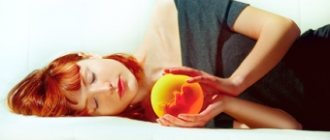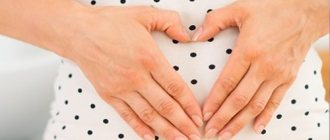Acute or chronic inflammation of the pancreas is called pancreatitis. Symptoms of pancreatitis are similar to those of food poisoning. Therefore, some people, feeling nausea and pain in the abdomen, are in no hurry to consult a doctor for help. They try to improve their condition on their own by rinsing the stomach and drinking large amounts of carbonated water, which causes further harm to their body. The consequences of advanced pancreatitis are irreversible, so it is very important to know everything about the disease, especially how to recognize it in the initial stages.
Structure and functions of the pancreas
What it is, pancreas, is usually known only to people involved in medicine. This is how the term “pancreas” sounds in Latin. Pancreas is an organ of the digestive system. Doctors conventionally divide the pancreas into a head with a process, a body and a tail. In fact, the gland has a more complex structure. It consists of two functional halves (exocrine and endocrine), each of them has its own purpose.
The exocrine is the larger half of the pancreas. It has many small excretory ducts and one large one, through which pancreatic fluid is excreted into the lumen of the small intestine. This liquid consists of digestive enzymes - amylase, lipase, trypsin.
Endocrine - the smaller part of the organ, consists of the islets of Langerhans, which are hormone-producing (endocrine) cells. The function of the islets is to produce hormones that:
- responsible for blood sugar levels (insulin and glucagon);
- regulate the secretion of glands that produce hormones (somatostatin);
- stimulate appetite (ghrelin);
- stimulate the production of gastric juice and suppress the activity of the pancreas (pancreatic polypeptide).
If the exocrine part of the pancreas secretes secretions through the excretory duct, then the endocrine half of the organ does not have excretory canals and releases its secretions (hormones) directly into the bloodstream and lymph flow.
The main function of the pancreas is to digest fatty, carbohydrate and protein foods. The enzyme lipase and bile acids are responsible for the breakdown of fats into fatty acids, which are then absorbed by the walls of the small intestine. Complex carbohydrates are broken down by the enzyme alpha-amylase into glucose and maltose. Proteases provide the breakdown of protein into peptides and amino acids.
What is pancreatitis
The disease pancreatitis occurs as a result of inflammation of the pancreas tissue. The inflammatory process is provoked by blockage of the excretory ducts of the gland, through which pancreatic juice enters the duodenum for the purpose of digesting food. The properties of digestive enzymes are such that they can destroy not only the glandular tissue of the pancreas, but also parts of other organs adjacent to it.
It is reliably known what causes pancreatitis in humans. As a rule, the risk group includes people who drink alcohol, as well as lovers of spicy, fried and fatty foods. But the most accurate answers to the questions of what pancreatitis is, how to treat it and what the prognosis of the pathology can be given only by a highly specialized medical specialist.
As a rule, the causes of blockages of the excretory ducts are the formation of stones, adhesions or tumors. In the clogged ducts of the pancreas, strong pressure arises, as a result of which the neighboring tissues of the organ are compressed, blood circulation in them is disrupted, and they die.
In some cases, the pressure in the gland ducts is so strong that their walls cannot withstand it and rupture. As a result, the tissues of the organ are saturated with pancreatic fluid, after which they are digested by activated digestive enzymes. The pain syndrome of the acute form of the disease is so strong that a person experiences a painful shock and loses consciousness.
Knowing what kind of disease this is and how dangerous its consequences are, you should not engage in self-diagnosis and self-medication. At best, this will lead to the pathology taking a chronic form, at worst - to death.
The main causes of chronic pancreatitis are an untreated acute form of the pathology (the patient violated the doctor’s recommendations), uncontrolled use of medications and alcohol abuse. The condition of the pancreas deteriorates irreversibly; its parenchyma is gradually replaced by connective tissue.
A chronic disease periodically makes itself felt with pain in the upper abdomen after eating unhealthy food. Further, in the absence of supportive treatment, the gland tissue melts, and the production of enzymes that facilitate the digestion of food is reduced. The pancreas atrophies and stops producing hormones, resulting in a person developing diabetes mellitus.
Causes of pain during pancreatitis
When the pancreas becomes inflamed, the digestion process is disrupted.
Pathological changes in organ tissue lead to swelling of the ducts connecting it to the intestines. Bile acids and enzymes are retained in the gland, aggressively affecting healthy cells. As a result, food products entering the gastrointestinal tract are not completely digested, but are retained in the stomach, pancreas and intestines. Additional foci of inflammation appear. Against this background, bloating, uncontrolled vomiting, ulcerative lesions of the walls of organs, and infection develop.
All pathological processes are accompanied by pain in the abdominal area. When the disease worsens, the localization of spasms is difficult to determine. Eating fried, smoked, spicy, sweet foods and alcohol aggravate the situation, provoking an attack of pancreatitis.
Pain due to inflammation of the pancreas occurs due to various factors:
- hereditary causes;
- eating disorders (alcohol abuse, presence of heavy and irritating foods in the diet);
- diseases, neoplasms and injuries of the gastrointestinal tract;
- changes in hormonal levels;
- taking medications;
- disruption of the structure of the ducts, which makes it difficult for the flow of enzymes, further breakdown and digestion of food;
- destruction of the tissues of the pancreas and nearby organs under the influence of bile acids, the development of inflammation, swelling and compression of internal organs.
Pain due to inflammation of the pancreas occurs due to various factors.
As a result of inflammation on the pancreas and surrounding organs, erosive ulcerations, cysts and fistulas occur, which also provokes pain.
Such a pain?
During an acute attack, the patient suffers severe pain, which can only be relieved with the help of medications. The nature of the pain syndrome in a chronic course depends on the individual characteristics of the disease, the degree of damage to pancreatic tissue, the frequency of attacks and the patient’s lifestyle.
During an acute attack, the patient suffers severe pain, which can only be relieved with the help of medications.
At times, patients experience pain on an empty stomach (in the morning before meals or at night). These pain sensations can occur against the background of an ulcer accompanying pancreatitis.
Sometimes a dull or aching pain appears at night, which is caused by a diet disorder or overeating at night. A damaged pancreas does not produce enough enzymes necessary to digest food, which creates additional stress on it, causing spasms.
During an exacerbation, constant pain of a girdling nature occurs after eating. When eating prohibited foods, negative symptoms may intensify.
In case of burning and sharp pain, accompanied by nausea, vomiting, diarrhea, chills and high fever, the patient should immediately consult a doctor. Such an attack can only be relieved in a hospital setting.
Most often, pain occurs after eating and lasts for a long time. When the disease worsens, they can only be removed with the help of medications. In different patients, the duration of an acute attack can vary from several minutes to several days.
After relief of symptoms, pain may continue for another week, sometimes intensifying at night.
The duration of the pain syndrome depends on the individual characteristics of the body and the thoroughness of following the recommendations of the attending physician.
Most often, pain occurs after eating and lasts for a long time.
The location of pain during an attack depends on the damaged part of the pancreas.
Patients themselves cannot determine the exact location of the pain; according to doctors, its most likely source is in the epigastric region.
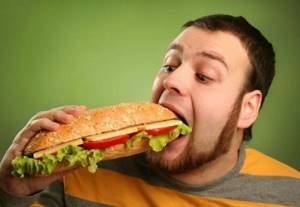
The pancreas is surrounded by a large number of nerve endings, which are subject to pressure during inflammation and swelling. Therefore, pain radiates to various organs.
In the anus
Often an attack of pancreatitis is accompanied by bloating and stool disorders (constipation or diarrhea), causing pain in the perineum. Poorly digested pieces of food cause the development of an inflammatory process in the rectum and anus, which results in painful sensations during and after bowel movements.
A spasm, similar in nature to intercostal neuralgia, occurs when the tail of the pancreas is inflamed.
The swollen organ puts pressure on the nerve processes, and the pain is localized in the left hypochondrium.
During the inflammatory process in the head of the gland, spasm is observed in the right part of the peritoneum with localization in the right hypochondrium. Depending on concomitant diseases, pain can be of varying intensity.
Continuous intense spasms in the chest with pancreatitis should be distinguished from heart pain with angina pectoris, characterized by undulations.
Continuous intense spasms in the chest with pancreatitis should be distinguished from heart pain with angina pectoris, characterized by undulations. During a medical examination of the patient, increased pain upon palpation of the pancreas is noted.
In the lower back
Girdle pain during pancreatitis due to compression of the spinal nerve endings causes irradiation to the lumbar region, sacrum and perineum. These symptoms, in the absence of an accurate diagnosis, can be mistaken for manifestations of diseases of the kidneys and urinary system.
Abdominal areas
The inflamed head of the pancreas provokes pain in the right side, which intensifies in the presence of stones or a cyst.
With gastritis, which often accompanies pancreatitis, part of the undigested food remains in the stomach, causing irritation and pain.
Acute attacks of pancreatitis are characterized by spasms in the left side with effects in the lower abdomen. The disease is aggravated by putrefactive processes in the intestines that occur against the background of insufficient digestion of food, and is fraught with infectious contamination of internal organs.
With pancreatitis, the body's reserves of calcium and other essential elements decrease, which contributes to the development of diseases of the musculoskeletal and nervous systems. Patients suffer from migraines, their joints hurt in their knees and elbows.
Treatment of the disease is carried out according to the results of a diagnostic examination, which is prescribed at the first signs of the disease.
An ultrasound examination of the abdominal cavity is performed, and if necessary, radiography and MRI are prescribed.
To diagnose the state of the digestive organs, a scatological examination of stool is necessary, the data of which may indicate disorders of the digestive process.
General and biochemical blood and urine tests are performed, an analysis for pancreatic enzymes (the content of trypsin, lipase, amylase and their effectiveness), and in case of concomitant diseases, a blood sugar test is performed.
To relieve and relieve pain during exacerbation of pancreatitis at home, you need to follow 3 main rules:
- To relieve swelling, it is recommended to apply a cold compress to the affected area;
- You should completely stop eating for the period of exacerbation (1-2 days), replacing it with drinking warm water (2 liters or more per day);
- complete rest and lack of psychological and physical stress.
Drug treatment is carried out in accordance with the instructions of the attending physician.
Treatment
In order not to provoke an intensification of the attack, in the first few days after its onset the patient is on a starvation diet.
It is allowed to take alkaline mineral and drinking water without gas and weak rosehip decoction. Gradually, various pureed soups, jelly and porridges are introduced into the menu.
At the same time, medications are taken to relieve pain and help restore pancreatic function.
Medication
To relieve pain, antispasmodic drugs are used that reduce muscle tone (Drotaverine tablets, No-shpa). Painkillers and antipyretics (Paracetamol, Ibuprofen) help relieve symptoms of inflammation. Taking diuretics helps eliminate edema (Furosemide, Lasix).
https://www.youtube.com/watch?v=qmBDBh9fdPs
Prevention of the development of infectious infection is carried out using penicillin antibiotics or cephalosporins. An important direction in the treatment of chronic pancreatitis is the normalization of the production of necessary enzymes by the pancreas. In case of their deficiency, the drugs Panzinorm, Festal, Creon, Pancreatin are used.
With exacerbation of pancreatitis, the pain is girdling in nature, radiating to the left or right hypochondrium. When the entire organ is affected, pain appears behind the sternum and in the back, intestines.
Acute cholecystitis is characterized by pain in the right hypochondrium radiating to the back, provoked by overeating, poor diet, and physical activity. Pain is present in the upper abdomen, an attack of biliary colic occurs, associated with a violation of the outflow of bile.
The appearance of pain during pancreatitis in men is often associated with the acute onset of the disease, provoked by excess food or alcohol intake, or excessive physical activity.
Many of them consider the onset of the disease to be a simple eating disorder and rarely turn to doctors.
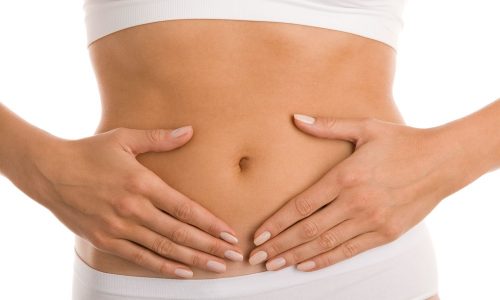
The intensity of the pain increases after eating and drinking alcohol, radiating to the back, forearms, and sternum.
When the disease becomes chronic, dull, aching pains become regular and last 2-3 hours, slowly losing intensity.
The occurrence of pancreatitis in women is often associated with eating disorders, irregular food intake, and bad habits. Its occurrence is also provoked by problems with excess body weight and attempts to lose weight using various diets with a reduced content of proteins and fats in food.
Often the cause of the inflammatory process in women is pathologies of the gastrointestinal tract, impaired bile outflow and the development of cholelithiasis.
Due to the female nature of the pain, pain is patiently tolerated for a long time, which contributes to the development of inflammation and an increase in the lesion.
With age, the risk of acute pancreatitis in women increases, which leads to the need for surgical intervention in 30% of patients.
Due to the female nature of the pain, pain is patiently tolerated for a long time, which contributes to the development of inflammation and an increase in the lesion.
During pregnancy
Types of pancreatitis
Due to the fact that pancreatitis of the pancreas develops and proceeds differently in each person, doctors classified the pathology taking into account its characteristics.
With the flow
Today, 6 main types of pancreatic inflammation are diagnosed:
- Acute pancreatitis. Rapidly developing inflammation. Without treatment, there is a high risk of irreversible changes in organ tissue.
- Acute recurrent. Attacks of acute pancreatitis recur within 6 months.
- Recurrent chronic inflammation of the pancreas. It has acute symptoms, but after treatment the organ tissues are not completely restored.
- Obstructive. Calcifications (deposits) are present in the excretory ducts of the organ; the excretory channels are expanded or narrowed.
- Chronic non-obstructive. The exocrine part of the pancreas loses its functions due to tissue destruction, the endocrine part is less affected. The excretory ducts expand, pathological fluid accumulates in the tissues of the organ, and pseudocysts form.
- Calcific. A variety and independent form of non-obstructive type. It is accompanied by the deposition of calcium salts not in the ducts of the organ, but in its parenchyma.
Acute and recurrent pancreatitis differs from the chronic form of the pathology in that in the first two cases the pancreatic tissue can be restored completely, and in the latter, structural and functional disorders remain after treatment.
According to the nature of the gland damage
Edema is the initial stage of the inflammatory process. It ends on its own or progresses to pancreatic necrosis. Gallstones can cause swelling by blocking the gland duct.
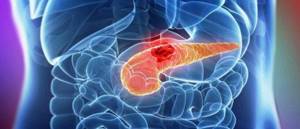
During the diagnosis of pancreatitis, the pancreas is examined for the nature of damage to its tissues.
The destructive nature of the lesion is when there is complete or partial death of organ tissue. Another name is pancreatic necrosis. Its varieties:
- small-focal - affects the tissue of one anatomical part of the organ (tail, body or head);
- medium- and large-focal - differs from small-focal in the size of the area of pancreatic lesions;
- subtotal - the tissues of most of the organ die;
- total - complete necrosis of tissue of all parts of the pancreas.
According to the phase of disease development
Acute pancreatitis has the following stages of development:
- Enzymatic - observed for the first 3-5 days. At this time, tissue death occurs and endotoxicosis (the release of toxins into the body) is observed.
- Reactive - begins in the second week of illness. Characterized by sterile inflammation (that is, without the influence of microbes) against the background of foci of necrosis. Clinically, this condition is expressed by parapancreatic infiltrate (accumulation of foreign elements in cells with lymph and blood) and resorptive fever (increase in temperature by 1-2°C due to tissue breakdown products entering the blood).
- Sequestration occurs in the 3rd week of the disease and can last up to six months. Sequestra (areas of dead tissue among living tissues) begin to appear 10-14 days after the onset of the disease. The pathology has two types: sterile pancreatic necrosis with the formation of cysts and infected with a purulent complication.
The outcome phase is predicted six months after the onset of the disease. Possible outcomes: complete or incomplete recovery, persistent pathological changes in the organ, death.
Phases of the course of chronic pancreatitis:
- Asymptomatic. Pathology is detected by chance, based on the results of laboratory tests of blood or urine, as well as during ultrasound of the abdominal cavity.
- With clinical manifestations. Chronic pancreatitis is divided into 4 stages, each of them has its own substages, differing in the intensity of pain, the presence of complications and the duration of the pathology.
Classification
It is customary to distinguish acute and chronic pancreatitis according to the clinical picture and the activity of the process.
Acute pancreatitis is an acute aseptic inflammation of the pancreas, in which pancreatic enzymes are activated, which leads to autolysis (digestion of one’s own parenchyma). In this case, a vicious circle forms: the more cells are damaged, the more enzymes “break out” and continue to destroy the organ. Local inflammation (pancreatitis) develops in the body, and powerful intoxication with enzymes and breakdown products of gland cells occurs. Many organs and systems suffer, because toxins are carried by the bloodstream.
The following changes occur in the gland: swelling of the tissue, an increase in its size, necrotic processes and diffuse inflammation of the fatty tissue around the pancreas.
Acute pancreatitis is divided into two forms:
- Edematous pancreatitis.
- Necrosis of the pancreas (pancreatic necrosis). There are three types (purulent, hemorrhagic, fatty).
The edematous form is characterized, as the name implies, by swelling of the pancreas. At the same time, its tissue becomes denser, but the lobulation of the structure remains, and hemorrhages do not appear. Exudate may accumulate under the liver. In some cases, it is possible to visualize areas of fat necrosis of the organ (these are dead areas). In this form, other organs and tissues are not affected.
With the fatty type of pancreatic necrosis, the organ is also swollen and enlarged in size, but the lobular structure is damaged. The tissue and parenchyma of the organ, the greater omentum, and the abdominal cavity contain many areas of necrosis. At the same time, up to 200-300 ml sweats into the abdominal cavity. serous fluid containing enzymes. The hemorrhagic type of pancreatic necrosis is characterized by the formation of foci of hemorrhage in the tissue of the tail and head of the gland. In the parenchyma itself, a large number of areas of necrosis are observed, the tissue surrounding the pancreas swells. In the abdominal cavity there can be up to 1 liter of hemorrhagic fluid with many enzymes and toxic substances that are dangerous to the body.
Purulent necrosis of the pancreas is characterized by the formation of necrotic areas with purulent contents in the area of the head, tail and body of the organ; pus melts the tissue of the gland and the fiber around it. The fluid that accumulates in the abdominal cavity is already purulent.
Inflammation of the pancreas causes very serious complications that are often difficult to prevent:
- Bleeding.
- Inflammation of the tissue around the organ.
- Abscess.
- Purulent or enzymatic pancreatitis.
- Jaundice of mechanical origin.
- Formation of fistulas (external, internal).
- Formation of a false cyst.
- Complications from the respiratory system.
How does pancreatitis manifest?
Symptoms of pancreatitis, especially the acute form, are pronounced, so it is impossible not to pay attention to them. They mainly manifest themselves as pain in the upper abdomen, severe digestive disorders and poor health.
Spicy
Main symptoms of pancreatitis:
- Disruption of the gastrointestinal tract. Bloating, vomiting and nausea are the first signs of pancreatitis.
- Severe pain in the upper abdomen, it can become girdling and radiate to the lower back.
- Low-grade fever (37.1-38°C).
- A white coating forms on the tongue, and dry mouth appears. The reason is a decrease in the functions of the salivary glands.
- Dizziness, headaches, increased sweating. This manifestation of symptoms is characteristic of severe poisoning of the body with toxins that enter the blood from the damaged pancreas.
- Increased blood pressure.
- Change in skin tone to pale, bluish, jaundiced in the back and abdomen. The reason is severe damage to the parenchyma of the organ, from which blood begins to flow under the skin.
Symptoms of acute pancreatitis develop similar to severe food poisoning. In order not to start treating a non-existent disease, you need to know what signs distinguish acute inflammation of the pancreas from intoxication of the body caused by poor quality food or another factor.
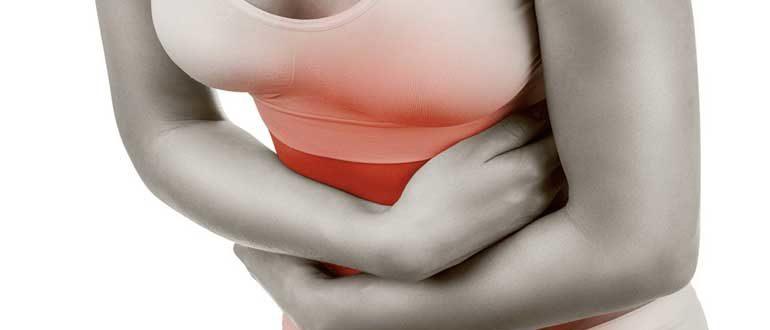
Knowing all the symptoms and signs of pancreatitis (where it hurts, how the skin tone changes, to what extent your health may worsen), you should not self-medicate. All that can be done in case of severe pain before the emergency medical team arrives is to take a No-shpa forte tablet.
The main symptom that will allow the patient to independently distinguish between these two types of pathology is bowel dysfunction. When food poisoning occurs, the first symptoms a person experiences are nausea, vomiting, and watery, foul-smelling diarrhea. In acute pancreatitis, on the contrary, constipation is observed, pain appears (constant, cutting, dull) in the upper abdomen, nausea and vomiting, sometimes with an admixture of bile.
Chronic
Unlike the acute form of pathology, the signs of chronic pancreatitis are more erased. This factor especially concerns the initial (asymptomatic) stage of chronic inflammation, which can last 5-10 years. The main symptoms of chronic pancreatitis that cannot be missed are the onset of pain approximately 15 minutes after eating unhealthy food. The condition may be accompanied by mild nausea, bloating, and diarrhea.
The symptoms of pancreatitis, which has existed for more than 10 years, differ from the asymptomatic stage of the pathology in that exacerbation of pain is rare (the reason is the replacement of tissue with pancreatic connective tissue). In such patients, the pancreas ceases to produce the required amount of pancreatic juice, which is manifested by weight loss, pallor and dry skin, and periodic bowel dysfunction. Patients rarely complain of appetite.
Clinical picture
Now let’s look at what symptoms a patient experiences with different types of pancreatitis.
Acute form
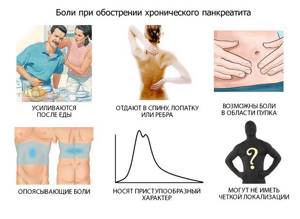
Pancreatitis of the gland in the acute phase has pronounced symptoms: pain in the left corner or in the middle of the abdomen. In the acute course of the disease, the pain may intensify after a fatty meal.
Note that the pain is constant or paroxysmal in nature, and intensifies when the patient is lying on his back. Therefore, to make the condition less painful, you need to choose a comfortable sleeping position.
In addition to pain, the patient experiences nausea, including severe vomiting, and often experiences fever and sweating.
Pancreatitis its signs (additional):
- Bloating;
- Clay-colored stool;
- Hiccups;
- High or low blood pressure;
- In the umbilical region, the patient has cyanosis or greenish-blue spots.
Remember, if you recognize the first signs of pancreatitis in time and begin timely treatment, the disease will not progress to the chronic stage.
Symptoms of pancreatitis in the chronic stage differ from the acute course of the disease.
Chronic pancreatitis
The first symptoms of pancreatitis are pain, but it occurs in the upper and middle abdomen. The main symptoms of pancreatitis in adults:
- Diarrhea;
- Nausea;
- Vomiting, but periodic;
- Severe belching;
- Rumbling in the abdomen;
- Steatorrhea means that the patient’s stool is greasy or has a mushy consistency;
- General malaise;
- The blood test showed an elevated ESR.
Note that pancreatitis has unique symptoms, because often in the chronic course of the disease Tuzhilin’s sign occurs.
What does it mean? Many people confuse this symptom with another disease.
Therefore, if you have red droplets on the skin in the chest area or on the back, and there are no other symptoms, this does not mean that you may not have chronic pancreatitis. Therefore, in order to make an accurate diagnosis, it is necessary to undergo a series of diagnostic examinations.
Also read: Exacerbation of chronic pancreatitis symptoms and treatment
Reactive pancreatitis
Reactive pancreatitis, its symptoms and treatment in adults in this form differs from other types of the disease. Indeed, with reactive pancreatitis, the initial symptoms are mild. Therefore, treatment of pancreatitis in adults follows a symptomatic course.
As for the early clinical picture, the patient experiences: bloating, heartburn, slight heaviness in the abdominal area and nausea. If the patient is not provided timely first aid for pancreatitis (reactive), then the patient will experience vomiting in addition to the symptoms described above, the body temperature will rise, and general intoxication of the body will occur.
Inflammation of the pancreas in children
Pancreatitis also occurs in childhood, but its course is most often unnoticeable, which causes the pathology to become chronic. The main signs that appear at the initial stage of development of pancreatitis are considered to be a child’s lack of appetite, fatigue and frequent mood swings.
Often the pathology is disguised as other diseases that have similar symptoms - gastritis, dysbacteriosis, peptic ulcer, intestinal obstruction.
As a rule, attacks of pain occur a few minutes after eating spicy, too salty or fried foods. If a child vomits, it does not bring relief, as happens with a normal stomach upset.
The most common causes of pancreatitis in children:
- lack of diet;
- eating junk food;
- long-term medication use;
- physical trauma to the abdomen;
- food poisoning;
- defects of the digestive system;
- helminthic infestation.
Treatment of acute or chronic forms of pancreatic inflammation in children should be carried out under the supervision of a doctor in a hospital. The treatment regimen is drawn up individually for each patient. As a rule, it includes nutritional adaptation and medication.

Symptoms of inflammation of the pancreas in children, as in adults, can also manifest as acute girdling pain in the upper abdomen.
On the first day of treatment, the child is prescribed a starvation diet, and then a gentle diet, which consists of foods that do not stimulate the production of digestive enzymes by the gland. Young patients are prescribed alkaline water and intravenous glucose, and if necessary, hemodez or rheopolyglucin are infused.
To relieve pain, the following is prescribed:
- Analgesics and antispasmodics - to relieve pain (Paracetamol, No-shpa, Papaverine).
- Enzyme preparations - to improve digestive function (Pancreatin).
- Antisecretory agents - to suppress the activity of the secretory function of the glands (Aprotinin).
- Antihistamines - for itchy skin rashes resulting from intoxication of the body (Diazolin, Suprastin).
- Antibiotics - to relieve inflammation in advanced forms of pancreatitis (Ceftriaxone, Cefotaxime).
If pancreatitis cannot be cured using conservative methods, surgery is used. The affected part of the organ can be removed, the gallbladder can be cut out, necrotic areas of tissue can be excised, and the abscess can be opened and drained.
Characteristics of pain
The nature and localization of pain in pancreatitis can be considered individual, but on the other hand they depend on the course of the inflammatory process. In acute pancreatitis, pain occurs immediately after eating a food irritant. With the progression of pathological disorders, the pain of pancreatitis gradually increases.
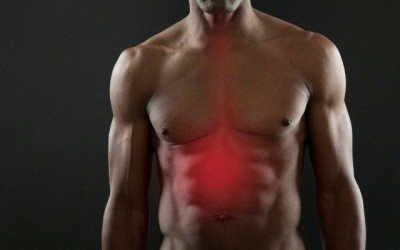
The patient rushes about in an unsuccessful search for a relieving position. However, in most cases, neither the “embryo” position (legs pulled up to the stomach), nor the side position, nor the half-sitting position bring long-awaited relief. In a supine position, more pronounced pain symptoms are observed.
Often, pain with pancreatitis is localized in the upper abdomen. Usually this is the epigastric part, but sometimes the pain can shift to the left or right hypochondrium. Occasionally, pain in acute pancreatitis resembles the pain characteristic of angina pectoris.
They manifest themselves as baking, burning unpleasant symptoms in the chest area, spreading to the left side of the back, the left side of the lower jaw or arm. Chronic pancreatitis manifests itself in that the pain does not have a clear localization. They can vary in intensity:
Most patients suffering from chronic pancreatitis experience periodic pain, in other words, a cramping type. With pancreatitis, pain can vary in intensity. But most often it is so high that even mental disorders can occur.
Expert opinion
Guseva Yulia Alexandrova
Specialized endocrinologist
Note! Pain in chronic pancreatitis is directly related to the consumption of fatty, spicy or fried foods and alcohol. The first signs of pain are observed half an hour after eating.
Ulcer-like pain, that is, pain on an empty stomach, is observed very rarely. Sometimes after periods of improvement there are periods of increased pain.
If the pain has disappeared, this is not always a reason for joy. This is especially true in situations where the pain was very severe. Its sudden disappearance indicates that necrosis is developing in most tissues.
Morbidity statistics
According to statistics, pancreatitis is a very common disease in Russia. Causes:
- 40% of patients are people who frequently drink alcohol.
- 30% - the pathology arose due to cholelithiasis and blockage of the excretory duct of the gland.
- 20% - pancreatitis was caused by excess weight.
- 5% - congenital pathology of the digestive organs led to inflammation of the pancreas.
- 4% - long-term or uncontrolled treatment of any disease with potent drugs, intoxication of the body.
- 1% - the causes of pancreatitis have not been established.
According to world statistics, about 800 people per 1 million of the world's population fall ill with pancreatitis every year.
Which doctor should I contact for pancreatitis?
If pancreatitis is suspected, the patient is hospitalized, after which the following doctors take care of his health:
- The therapist examines the patient: palpating the abdomen to identify the location and nature of the pain.
- Oncologist - deals with patients in whom neoplasms were detected by ultrasound of the pancreas.
- Reanimatologist surgeon. Pancreatitis is treated with the participation of this specialist when the patient was hospitalized with symptoms of a severe attack (fainting, high temperature).
- Gastroenterologist - treats patients who are recovering. In addition to medications, he prescribes a therapeutic diet.
- Endocrinologist - monitors the progression of pancreatitis. Deals with the prevention of complications such as diabetes.
Subsequently, the attending physician of the patient who has suffered inflammation of the pancreas becomes a general practitioner.

If you notice symptoms of pancreatitis, we advise you to immediately consult a doctor. This could save your life.
The doctor monitors the health of the gland and periodically refers the patient for examination to specialized specialists.
Diagnostic methods and necessary tests
The doctor makes a diagnosis of acute or chronic pancreatitis based on the results of the examination of the patient. To accurately diagnose the disease, the patient is prescribed:
- Biochemical and general blood test.
- Urine and stool analysis.
- Ultrasound of the abdominal cavity.
- X-ray of the pancreas.
- Examination of the gastrointestinal mucosa (EGD procedure).
- Examination of the gallbladder and excretory ducts of the gland (ERCP procedure).
Pancreatitis has symptoms similar to those of other diseases of the digestive system - acute intestinal obstruction, peptic ulcers. Therefore, some patients may be prescribed differential diagnosis to identify pathological signs characteristic only of pancreatic disease.
How to treat acute pancreatitis
Treatment of acute pancreatitis requires an integrated approach, so a patient with inflammation of the pancreas is hospitalized. After making an accurate diagnosis, the attending physician creates an individual treatment plan for the patient.
Pain relief
In the acute form, severe pain occurs. In this case, treatment of pancreatitis begins with analgesics (Baralgin, Pentalgin, Analgin) and antispasmodics (No-shpa, Papaverine). The drug Atropine in the form of subcutaneous injections quickly relieves pain. An emergency physician can administer it to a patient.
Peace
A patient hospitalized with an acute pancreatic attack is provided with complete rest. The patient is placed on the bed. It is recommended that he tuck his knees to his chest, which reduces the pain.

It is impossible to completely cure pancreatitis. All doctors can do is relieve pain and stop the inflammatory process, and then continuously provide supportive treatment.
An ice compress is applied to the area where the gland is located, which also helps relieve pain.
Starvation
During attacks of acute inflammation of the pancreas, the patient is prescribed therapeutic fasting:
- For the first 2-3 days of hospitalization, the patient drinks only warm rosehip decoction or warm non-carbonated mineral water (Borjomi, Essentuki No. 17, Narzan). Cold liquid is strictly contraindicated, as its consumption leads to attacks of pain.
- On the 3rd or 4th day, the patient is given a little soup from grated vegetables and without salt (there should be at least 7 meals).
- On the 5th day the patient is prescribed dietary table No. 5.
During the period of remission (weakening or complete disappearance of symptoms of the disease), doctors recommend refusing food once a week for the purpose of prevention.
The nature and localization of pain in pancreatitis
The main symptom of pancreatitis is the occurrence of pain due to inflammation of the pancreas. The symptom develops against the background of an ongoing pathological process, directly in the pancreas. As a rule, the pain symptom occurs on the left side, directly under the ribs.
As soon as pain occurs, you should immediately consult your doctor. You should not think that if you eliminate the pain of pancreatitis at home, the symptoms will not appear for some time, then you have gotten rid of pancreatitis.
No, this disease requires complex therapy; you cannot simply take antispasmodic medications.
It is the symptoms of pain during pancreatitis that are the root cause of a significant deterioration in the general well-being of patients with this type of pathology, as well as a predisposing factor for an indispensable visit to a doctor.
When the pancreas is inflamed, the patient experiences not only pain, but also other symptoms characteristic of pancreatitis.
As for the pain symptom, it occurs against the background of various causes. For example, most often with pain due to pancreatitis, symptoms occur in the patient against the background of degenerative changes.

Every patient must understand that with dystrophic changes, pancreatic enzymes begin to gradually go beyond their anatomical boundaries. It is for this reason that the patient experiences pain.
The development of inflammatory disorders in the gland during the chronic form of damage to the parenchymal gland is accompanied by less intense painful manifestations.
The second no less common cause of pain in pancreatitis is a violation of tissue microcirculation. If there is a violation, there is quite pronounced swelling, which is characterized by rapid accumulation of fluid. Swelling causes pain in this disease.
Doctors noted that patients often experience pain due to a blockage, namely the duct of the gland.
In more severe cases, the main sign of the disease and other symptoms of pancreatitis occur against the background of existing purulent inflammation.
Acute or dull pain in the pancreas is a characteristic sign of the development of pancreatitis, which occurs due to a number of reasons
Remember that the symptom of pain must be eliminated, otherwise the disease will continue to progress and serious complications will arise.
When a disorder of the pancreas occurs, the patient may have a different type of pain due to pancreatitis. With pancreatitis, several characteristics of the symptom are noted.
- Paroxysmal. This sign indicates that the disease is progressing. Therefore, you should not try to eliminate paroxysmal pain on your own; you should immediately consult your doctor.
- If the disease occurs in a child, the pain resembles colic. Note that in early childhood the disease develops extremely rarely.
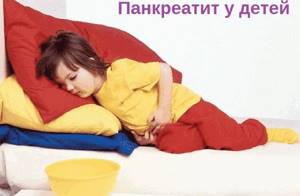
Pancreatitis in children is an autocatalytic enzymatic inflammatory-dystrophic lesion of the pancreas - The symptom of pain can be not only acute and burning in nature. Often the patient suffers from quite severe pulling or squeezing pain. This sign indicates an acute course of the disease. In acute pancreatitis, girdle pain also develops, which can be long-lasting.
- If the disease is chronic, the patient may also suffer from night pain. This symptom is rarely relieved by simple antispasmodic drugs; it is necessary to use complex therapy.
- Some patients with chronic pancreatitis experience dull pain.
Every patient should understand that pain due to an inflamed pancreas begins to intensify after eating fried or spicy foods.
The appearance of dull or acute pain in the epigastric area is an urgent reason for an urgent visit to a gastroenterologist, conducting a full diagnosis and prescribing appropriate treatment.
To prevent severe pain, it is necessary to adhere to proper dietary nutrition, this will help improve the functioning of the pancreas and relieve spasms. With pancreatitis, cysts can form, in which case the patient experiences moderate discomfort.
The main cause of cysts in pancreatitis is the death of glandular tissue. At the same time, connective tissue gradually begins to form and the organ increases in size. It is for this reason that pain occurs.
In medical practice there is such a thing as allodynia. What does it mean? In this case, the patient suffers from pain for a long time. With allodynia, there is a fairly pronounced pathological change in sensitivity.
Against this background, the main symptom is capable of penetration of an irritant, even if it has a minor effect on the patient’s body.
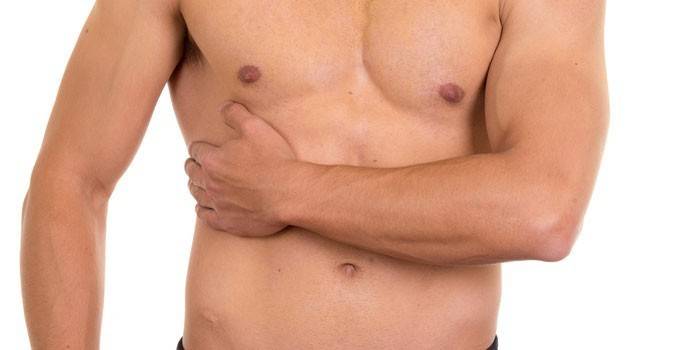
With pancreatitis, pain may be completely absent. This phenomenon occurs only if, during chronic pancreatitis, it was previously intense, but during the period of remission it is absent.
Additional symptoms of pancreatitis besides pain:
- The patient experiences severe nausea, including vomiting.
- There is a decrease in body weight due to lack of appetite.
- When gas accumulates, bloating occurs in the abdomen, which brings a lot of discomfort to the patient.
It should be noted that constant and quite severe pain can lead to psychological disorders. Therefore, it is necessary to take steps to prevent serious health problems.
This question is very difficult to answer. It is impossible to say exactly how long the pain with this disease will last. But there is a certain classification.
When painful sensations with high intensity suddenly stop their manifestation and the patient’s condition quickly normalizes, this may not be a reason for joy, but for additional diagnostic procedures.
In the first case, the symptom can last for 10 days, while a long-term remission is observed.
In the second case, the patient’s pain lasts for 30-60 days. The pain syndrome is long-lasting, so it most often speaks of alcoholic pancreatitis.
If it does not stop even after taking medications, then this is an indication for surgery.
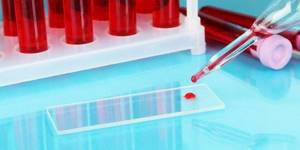
Let's answer the question, where does pancreatitis hurt? Pain can be localized in various areas. Most often, it is localized precisely in the epigastric region.
Pain may be associated with intraductal hypertension, caused by both a violation of the outflow of pancreatic juice and an increase in its volume as a result of increased stimulation.
But, in some cases, the symptom can radiate to the left hypochondrium. In most cases, pain from an inflamed pancreas radiates to the left shoulder blade, as well as to the arm.
If the disease occurs in a chronic form, then the pain syndrome is localized in the lower or middle part of the abdomen.
Very often, during the chronic course of the disease, pain occurs in the lower part of the chest. It is also common to experience pain in the lumbar region. Sometimes this problem cannot be controlled with simple antispasmodic drugs.
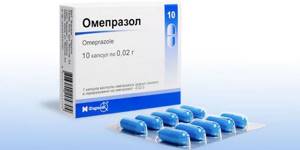
Intercostal neuralgia is also noted. To make it more clear, the pancreas is divided into several parts, namely the head, body and tail.
If the inflammatory process in a patient occurs precisely in the head of the pancreas, then the patient experiences pain strictly in the right hypochondrium. If the tail of the pancreas is affected, then pain occurs with pancreatitis in the left hypochondrium.
Often the pain radiates to the lumbar region. In this case, the patient experiences cramping pain, which may resemble renal colic.
With pancreatitis, calcium and other nutritional components are lost. This phenomenon entails pain in the joints.
In order to alleviate the general condition of pain, you must adhere to very simple rules.
- If you have pancreatitis, you need to avoid harmful foods. Stick to proper nutrition and exclude fried and spicy foods from your diet.
- If the pain due to pancreatitis is acute, then at home you can apply a cold compress to the abdominal area, which will help to slightly relieve swelling from the affected organ.
- Try to avoid stressful situations.
In addition, the patient must adhere to the correct drinking regime. Drink at least 2 liters of liquid per day.
In case of severe pain, it is necessary to take antispasmodic medications. Let's look at the most effective pain relievers.
But remember, if the remedies described below do not bring a positive result, you should immediately consult a doctor.
To eliminate the symptom, the patient is prescribed analgesics and antispasmodics. Antihistamines are prescribed in combination to quickly suppress the activity of the pancreas.
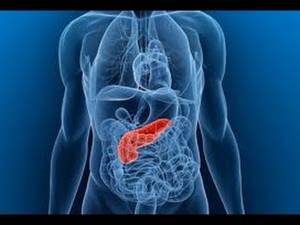
The dosage is selected taking into account the individual characteristics of the patient’s body. It is necessary to begin treatment with a minimum level of medication, with a gradual increase in dose.
To weaken secretory production, doctors can prescribe the patient the drug Omeprazole, the drug is a proton pump inhibitor.
To quickly relieve pain, doctors prescribe the drug Paracetamol to the patient. The drug has a fairly pronounced spectrum of action, since Paracetamol belongs to the analgesic-antipyretic group.
The main effect of the drug is aimed not only at eliminating pain; Paracetamol also has an anti-inflammatory spectrum. Therefore, it helps relieve signs of inflammation and eliminate other symptoms of pancreatitis.
For this disease, take the drug in a dosage of 200-500 mg. Note that the dosage is selected individually, depending on the type and severity of the disease. If the dosage is incorrectly selected, an adverse reaction occurs. Neutropenia or a severe allergic reaction occurs.
At home, during acute illness, you can take the drug Ibuprofen. Prescribed in the form of capsules or tablets.
How to treat chronic pancreatitis
When chronic pancreatitis becomes inflamed, the patient is prescribed treatment aimed at eliminating the cause that provoked the inflammatory process. At the stage of exacerbation of the pathology, the patient switches to nutritional therapy, takes medications that relieve pain and inflammation, and undergoes vitamin therapy.
Diet for chronic conditions
Treatment with diet almost always helps relieve the symptoms of pancreatitis. Therefore, in the chronic form of the pathology, doctors recommend that their patients eat foods containing large amounts of vitamins. Therapeutic nutrition involves complete abstinence from fatty, fried foods and alcohol.
The patient should eat only the foods that make up Diet No. 5, eating 3 times a day at the same time. For the first 2 days from the onset of an exacerbation, it is better to abstain from food altogether. You can drink unsweetened and weak tea, alkaline mineral water, but without gas, or a decoction of rose hips.
How to eliminate pain
In case of pancreatitis of the pancreas, pain is relieved with the help of non-narcotic (non-steroidal) analgesics such as Paracetamol and Ibuprofen. For severe pain, the patient is prescribed Ketanov or the narcotic analgesic Promedol.
Drugs
In addition to analgesics, patients with a chronic form of the disease are prescribed pancreatic enzymes (Creon, Pancreatin). After the medicine begins to act actively, the digestive process improves and the load on the gland tissue is reduced.
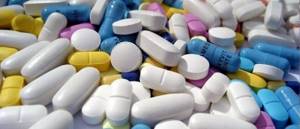
It is prohibited to take enzyme preparations on your own! They are prescribed only by a doctor, taking into account the characteristics of the disease.
Also, during the period of exacerbation of chronic pathology, the patient, in order to ensure functional rest of the pancreas and prevent an allergic reaction, must take drugs that block histamine receptors (Famotidine, Ranitidine).
Traditional treatment
Therapy of inflammation of the pancreas with diet and medications is often supplemented by folk remedies. The most effective anti-inflammatory recipes:
- Every day for 14 days you need to drink 0.5 cups of fresh potato juice on an empty stomach, and after 5 minutes - 200 ml of kefir. Take a break for 2 weeks, then repeat the course of treatment for the pancreas.
- 30 minutes before meals, take 1 tsp. milk thistle seed powder (3 times a day). The course of treatment should last at least 2 months.
- Half an hour before meals, drink 100 ml of fresh cabbage juice (3 times a day) for a month.
It should be done with caution. treat pancreatitis with herbal decoctions, since almost every medicinal plant has side effects, and some of them are poisonous.
Therapeutic exercises and lifestyle
You can improve the condition of the pancreas after discharge with the help of special physical exercises:
- Inhale deeply, then exhale, hold your breath, draw your stomach in, count to 3 and relax your muscles.
- Repeat the exercises of the first point, but inflate your stomach rather than retract it, then relax.
- When inhaling, pause for 1 second, then continue inhaling, slightly bulging the abdominal wall. Pause for a second and inflate your stomach, then you need to sharply relax the muscles and draw in the abdominal wall. Exhale and relax your abdominal muscles.
This therapeutic exercise should be performed 2 times a day.

In addition to breathing exercises, the patient is recommended to take daily walks in the fresh air 1.5 hours after meals.
If possible, visit the pool (swimming for 15-30 minutes). Ride no more than 20 minutes a day on a bicycle.
Treatment
Can pancreatitis be cured? Yes, but every patient should know how pancreatitis is treated and what to do in case of exacerbation.
So, during an exacerbation of the disease, the patient should lie down, and it is necessary to tuck his knees towards the chest. In this position you can get rid of pain.
How to relieve inflammation of the gland and swelling? The patient can apply a heating pad to the epigastric area. In this case, the heating pad should only be filled with cold water. If you don't have a heating pad, you can use simple plastic bottles.
How to treat pancreatitis with spam at home? If you are sure that you are not allergic to the drugs described below, you can take painkillers before the ambulance arrives.
For example:
- No-shpu, analogue of Drotaverine;
- Spasmalgon;
- Maxigan.
The very last rule to remember is not to eat. During an exacerbation, the patient is allowed to drink water, but only without gas, this will help reduce secretion production in a short period of time.
Now let's look at the main methods of therapy. There is a specific treatment regimen, which includes:
- Taking painkillers;
- Antienzyme and vitamin therapy;
- Restoration of acid-base balance;
- Pancreatitis is also treated surgically.

Many patients ask whether pancreatitis can be treated with diet? Let us immediately note that dietary nutrition is included in the treatment regimen described above, but is not the main one.
Therefore, the answer to the question - is it possible to cure pancreatitis forever with one diet, should be a lightning-fast answer - no.
Drug therapy
Initially, pancreatitis is treated with antispasmodics - they help eliminate pain.
Prescribed:
- Maxigan;
- Phenicaberane;
- But-shpu.
If the pain is not relieved, then doctors prescribe M-Anticholinergics.
For example:
- Metacin;
- Gastocepin.
When a patient with pancreatitis has persistent pain, it is impossible to completely get rid of the pain with the medications described above.
Complete relief from pain is achieved with the help of H2 blockers. Famotidine or Ranitidine may be prescribed.
Antienzyme treatment and vitamin therapy
Treatment is aimed at stopping all adverse processes that destroy the pancreas. Therefore, all antisecretory drugs are aimed at blocking enzymes and inhibiting protein synthesis.
Pancreatitis can be cured with: Fluorafor, Omez, Amidopyrine, as well as Gordox or
Nexium.
Remember, any type of pancreatitis can only be cured with complex therapy.
If a patient develops an edematous form of the disease, then Asparkam will help cure the edema.
Also read: Vomiting in acute pancreatitis: causes and help
Vitamin therapy involves taking vitamins from different groups. For example: vitamins B, C D, K or A and E. For severe weakness, cocarboxylase is prescribed.
Restoration of acid-base balance
How to treat inflammation? In order to cure inflammation, it is necessary to adjust the pH in the gastrointestinal tract.
As you already understand, with pancreatitis, acidity increases, to reduce it, you can take some antispasmodics. But this group of drugs does not always cope with the task. Therefore, doctors prescribe: Cimetidine, Gastal or Almagel.
Surgery
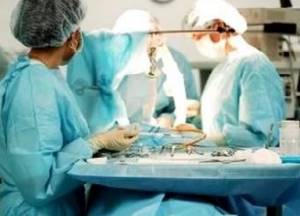
In severe cases of the disease, it is impossible to cure pancreatitis with drugs. So, for inflammation of the gland, all surgical treatment involves laparoscopy. After the operation, dehydration therapy is prescribed.
Now you know how to cure pancreatitis completely. Let's consider whether the gland can be cured using traditional medicine.
Is it possible to cope with pancreatitis at home?
Pancreatitis is difficult to treat, so it is impossible to cope with this pathology alone. Self-medication can cause death or disability of a person.
Complications of pancreatitis
The disease, if not properly treated, leads to complications:
- diabetes;
- chronic poisoning of the body;
- formation of cysts and abscesses in the pancreas;
- obstructive jaundice;
- necrosis of tissues of neighboring organs;
- death.
Late complications of acute inflammation of the pancreas, which can lead to death, most often manifest themselves as internal bleeding, the formation of fistulas and abscesses in the tissues of the digestive system.



